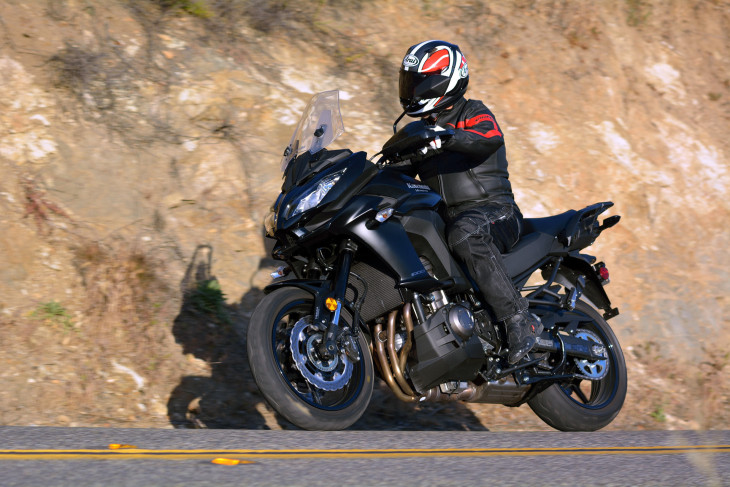
Life is full of surprises, even for a motorcycle journalist that has been testing bikes for close to two decades. The 2015 Kawasaki Versys 1000 LT has been one of those surprises.
When I picked up MD’s Versys 1000 LT test unit a few weeks ago, I wasn’t particularly excited. I thought the engine would be smooth and powerful (it is), because it is based on the same engine found in Kawasaki’s excellent Ninja 1000 and Z1000. This 1043cc inline four impressed us with its real world power and smoothness in both of those models.
The Versys 1000 is the heaviest model (a claimed curb weight of 549lbs. with the 5.5 gallon tank full) with that engine, however, and with its standard saddlebags attached can look a little too utilitarian in comparison with its siblings. The thought of a Ninja 1000 with more weight and a longer wheelbase (the Versys 1000 wheelbase is 59.8 inches, which is 2.9 inches longer than the Ninja 1000 wheelbase) didn’t get my juices flowing. Little did I know….
I wasn’t sure what category this motorcycle fit into. It has the bolt upright ergonomics and lengthened suspension travel (5.9 inches at both ends) of an adventure tourer, but 17″ wheels at both ends with excellent sport touring rubber (the Bridgestone T30s emphasize sport, and are very impressive).
It has some of the electronic sophistication of a sport bike with traction control (3 selectable modes suitable for everything from dry sport riding to rain – it can also be turned off), ABS brakes, 2 power modes (full power and reduced power for rain or other poor traction situations), and a slipper clutch.
This bike is comfortable, with a broad rider and passenger seating area, high wide bars and generous leg room. The wind screen is adjustable without tools over a 3 inch range, and hand guards are standard.
The engine is a gem. Redline is at 10,000 rpm, and the big Versys pulls smartly from just above idle. Power is strong all the way to redline. How strong? This is a fast motorcycle.
In the default traction control mode for dry roads, the front end would often float a nice power wheelie if I got on the gas hard. The front end would get light in 2nd gear as well … without using the clutch to aid the process. Impressive, and surprising for a bike this size.
The engine is smooth as well, with a counter-balancer and rubber mounted pegs and bars, vibration is not an issue.
All this was wonderful, but it was the handling that really impressed me. For some background, I fell in love with the comfort and steering leverage offered on Suzuki’s first generation V-Strom 1000 and 650, but always longed for better suspension, brakes and tires. The adventure category is full of great bikes now, of course, but few feature 17″ front wheels (Ducati’s Multistrada 1200 is an exception), and many have too much suspension travel for sporty street riding (even the street oriented Multistrada has nearly an inch more travel at each end, 6.7 inches versus 5.9 on the Versys). I also like the 180/55 size of the Versys rear tire, which I think strikes an excellent balance between grip and nimble handling.
The suspension on the Versys 1000 is adjustable for spring preload and rebound damping front and rear. The damping characteristics are excellent once you turn the rebound adjusters in a bit at both ends (I recommend 6 clicks out from full hard on the fork and one full turn out from full hard on the shock). The bike also benefits from additional shock preload and raising the fork tubes 5mm to shift weight forward (interestingly, the old V-Strom 1000 benefited from similar suspension adjustments).
The fork is a stout 43mm upside down design that helps keep things under control during aggressive riding. The brakes include dual front discs measuring 310mm and 4-piston calipers. Brake power never was an issue.
The six-speed transmission shifted flawlessly and offered a low first and second gear (remember those power wheelies?), as well as a tall enough sixth gear to keep things mellow on the highway. The clutch has a very light pull for such a powerful engine, and the slipper aspect kept the rear wheel under control while entering corners aggressively.
The stock Bridgestone T30 tires have surprising amounts of grip … superior to sport bike tires of just a few years ago. The tire profiles allow easy turn-in, while offering good high speed stability. Feedback is outstanding and provides plenty of confidence to explore big lean angles.
Speaking of lean angles, thanks in part to the longer suspension travel the Versys 1000 has plenty of ground clearance. You can take the tires all the way to the edge before the peg feelers touch.
Frankly, I liked the Versys 1000 LT so much I thought it might be interesting to present it as both a practical commuter/tourer with quality, integrated hard bags that can each swallow a full face helmet, as well as a capable sport bike at the same time. In roughly an hour, I stripped 40 pounds of weight off the bike with just common wrenches and sockets … putting its weight in the same ballpark as Ducati’s Multistrada (see photo). To convert the bike back to touring duty just add the rear brackets and luggage rack (a five minute process). A neat trick.
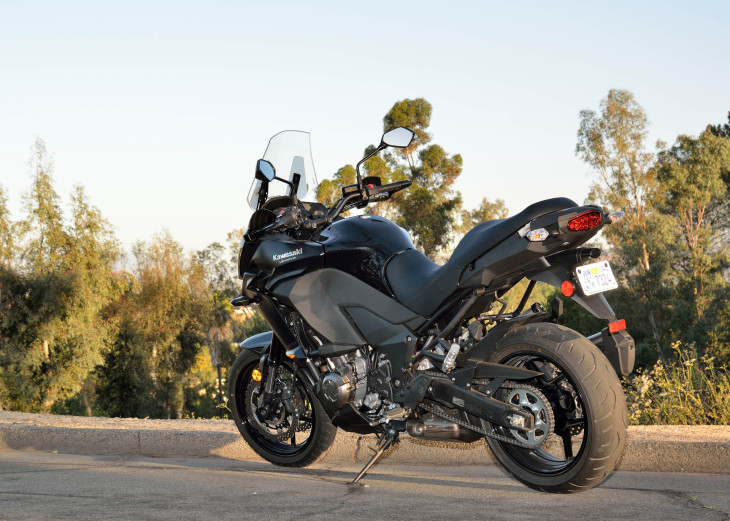
The Versys 1000 LT loses 40 pounds when you remove the luggage rack, saddle bags, center stand and stock Yuasa battery (replaced with a Shorai).
As I started to ponder a longer term project with the Versys 1000 LT, I had to return the bike to Kawasaki. Maybe later.
What Kawasaki presents with the Versys 1000 LT is a genuine do-it-all motorcycle. I hesitate to call it a jack-of-all trades, because it doesn’t do the bike justice. This is a comfortable tourer at the same time it offers near sport-bike levels of performance and handling. With fuel economy that easily reaches the mid-40mpg range when ridden conservatively and a 5.5 gallon tank, you could use it as your daily commuter as well.
The 2015 Versys 1000 LT is priced at $12,799 and is available in either Flat Ebony/Metallic Spark Black or Candy Burnt Orange/Metallic Spark Black.
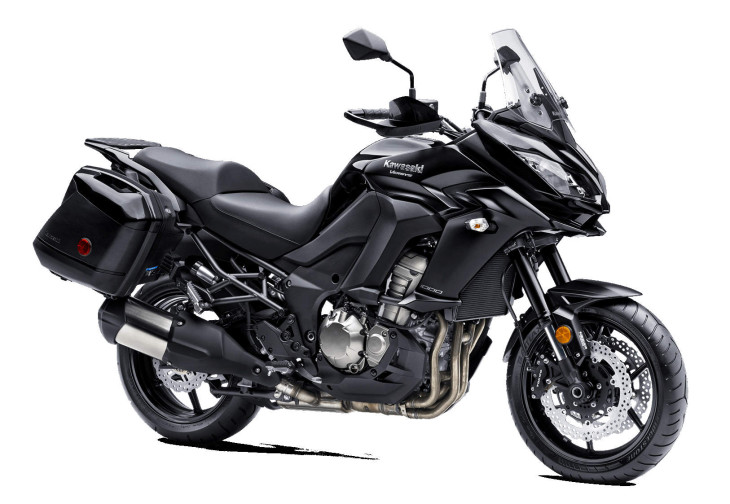
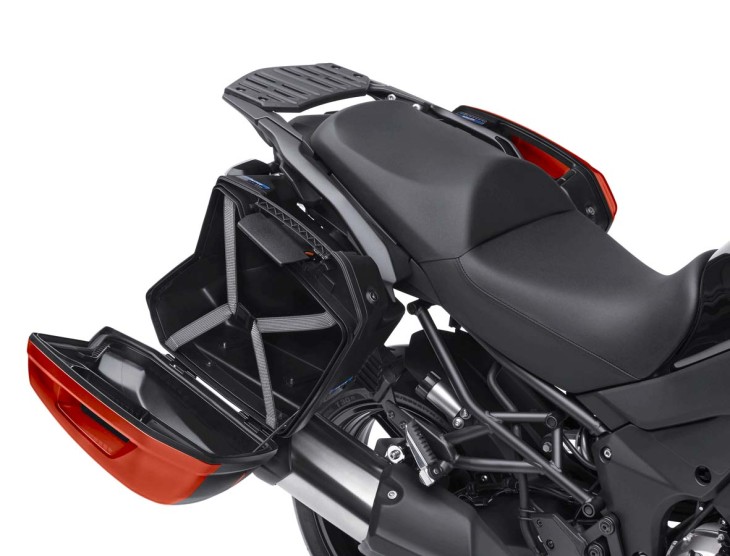
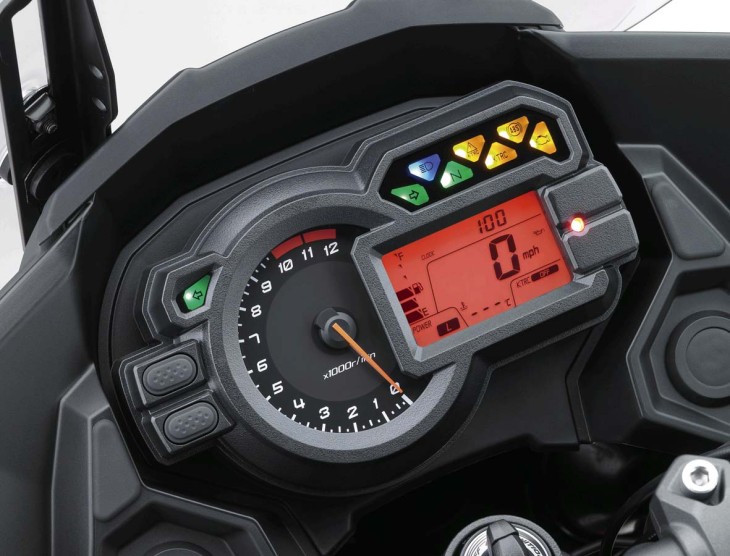
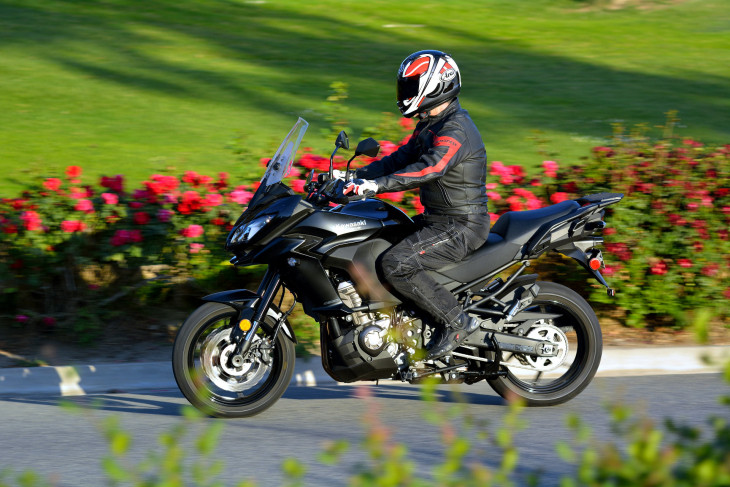
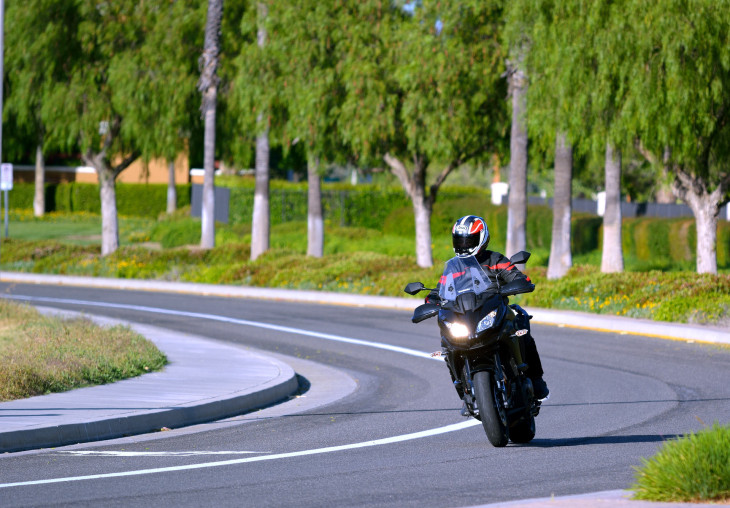
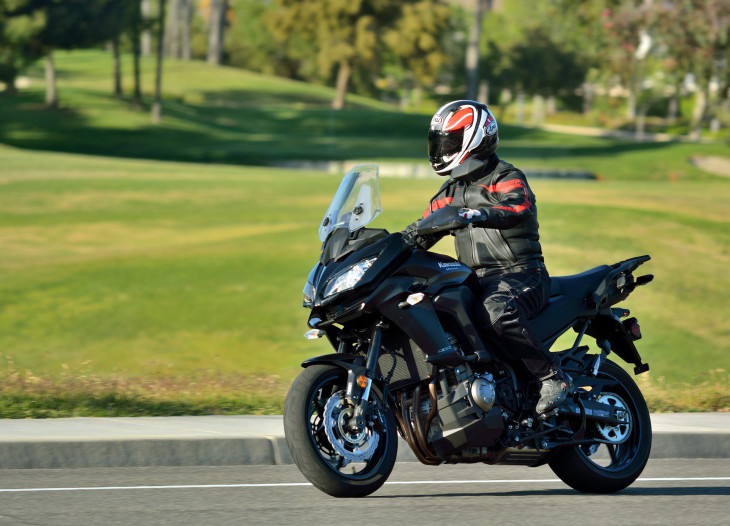






Yamaha launches new R1 adventure bike (snicker).
https://www.youtube.com/watch?v=Q5iU7twPOio
So when is BMW going to come out with a 6-cyl adventure bike? At what weight does a bike go from “Adventure” to “Porky Pig”? When will Honda wedge their Goldwing motor into a different frame and pronounce it an “Adventure” bike. Seems that anything with two wheels and a tall seat height qualifies for this category.
In all fairness, it is the media and we consumers really referring to it as an “adventure” bike. Kawasaki refers to the Versys 1000 as a touring bike.
RIGHT….
Tall Suspension and upright ergos don’t automatically equal an ADV Bike.
In fact, 17″ wheels scream out “I’m a street bike”. Any of which can go down a dirt road… especially if your willing to shod the bike with appropriate rubber.
We’ll have to use our noggins and look for 19″ – 21″ front wheel sizes to find “True” ADV Bikes. This Versys is simple a street bike thats set up at the other end of a growing spectrum; makes a good mount for an occaisional jaunt down a dirt road or two – not for a trek accross Mongolia.
This is a good thing; the expansion of a class of motorcycles. Who would’ve predicted 10 years ago that Triumph would be making 4 different middle-weight ADV Bikes????
The Versys are under STREET/TOURING on kawasaki.ca.
Kawasaki doesn’t have “adventure” category, but Kawasaki have the KLR for dual purpose bike.
I think you are getting caught up in semantics. The Kawasaki, like the Ducati and KTM 1290, are sport tourers. Realistic folks realize any bike more than 400 pounds has no business going off road. That includes the GS pig iron.
“Realistic folks realize any bike more than 400 pounds has no business going off road. That includes the GS pig iron.”
“Motocross” & “Off Road” aren’t exactly the same thing.
Me thinks you better cue up the movie “Long Way Around” & “Long Way Down” you be entertained, you’ll see two GS’s traverse Europe and Asia and Africa – which I think you’ll agree is technically “Off Road”.
Not to mention specifically all the motorcyclists who have traversed the globe on them…
I can ride an R1200R any place that Brit punk can ride his GS. The myth that these bikes are anything less than hobbled bison off-road is just that … a myth. They are no more off-road than most four-wheeled SUVs.
They are, however, excellent sport-touring bikes. And it is great to see Kawasaki, Ducati, Aprilia and KTM acknowledge that by dropping the off-road pretense altogether. Only BMW is left trying to convince you that these behemoths are dirt bikes.
Um ya, no, you can’t.
Behold the pissing contest
I will take a r1200r oof-road before a gs, because of weight, but again, both will need better tires.
“Realistic folks realize any bike more than 400 pounds has no business going off road.”
I really don’t know why people keep saying this. Just because you can’t land a double on a big adventure bike without triggering a mass extinction event doesn’t mean they can’t be very capable off-road machines.
I’ve taken “pig iron” places most people wouldn’t take their CRF250L. It’s loads of fun!
People would be surprised to see where they used to take stripped down Harley dressers and Sportsters with little or no rear suspension at all, 16″ wheels etc…through mud, up hills, through creeks, over jumps.
You guys must go read about David Barr (I think I spelt it right). I am not a Harley fan at all, but this guy went around the world on one – through the Sahara, Siberia etc. GS riders go off-road all the time. Just takes a bit of training.
Guys, its a large-displacement modern UJM. Period.
UJM. Universal Japanese Motorcycle. You clearly don’t understand that acronym. It is a term given to the naked era bikes from Japan in the 70′ and 80’s when they all felt and looked the same. Hardly looks or feels the same. This is an individual bike as you can get.
A couple of commenters have mentioned having to upgrade the stock suspension on th eYamaha FJ-09 in order to ride happy. I don’t get it. WHat doesn’t the stock suspension on the Yamaha do that needs to be done? Are you talking about “track-days,” because most riders either don’t do track days or don’t take a touring bike to track days. I certainly wouldn’t take a FJ-09 to the track.
So, what’s so bad about the FJ-09 suspension? You mean, it doesn’t work? I don’t get it.
Jamo, not everyone one is the same size or rides with equal enthusiasm. Forks and shocks built to a price point can’t cover the spread between the 140 pound easy rider and the 240 pound aggressive rider. They just can’t satisfy both. One will be over sprung with excessive compression and rebound the other might be just the opposite, under sprung with too little compression and damping. If you weigh 175 pounds, ride solo, and are a medium aggressive ride the forks and shocks will probably feel pretty good to you, but the guys at each end of the spectrum, light, heavy, easy, aggressive would probably benefit from a suspension upgrade.
Interesting, other testers havnt been so kind to this bike. Most described it as solid, comfortable, practical, but not as fun and engaging as is described here, the weight being the identified culprit. Guess it’s hard to really know unless you throw a leg over the thing. Either way this bike looks like a winner even tho I take my bikes with a bit more sport this.
They are flibbin nuts. I’ve been riding sporty bikes for several decades and I’ve never owned a bike that was so nimble in my life. It changes direction so easily, it’s hard for me to get used to. If anything, I wish it was a little harder to turn, a little less spunky off throttle, and the brakes were a little less effective, just so a picker like me could be a little smoother on it.
Sometimes it’s amazing what a simple swap of tires does to a bike’s attitude. I’ve had bikes go from being pretty good and stable at all speeds to falling into corners as if being telepathic with me and vice versa. Check out what others are saying about specific tire options and the results running them.
Hahaha I know right, I think it was MCN that wasn’t too thrilled with this bike and actually said the smaller Versys was much more entertaining. And yes tires can make a huge difference they are the only part of the bike actually touching the road afterall (unless you have ground clearance issues).
Yes, until you load it up with luggage and pillion, the the 650 becomes fairly useless.
Dirck, few people have had the chance to ride both. Which is quicker: this new Versys or the FJ09? I assume the Kawasaki would be more comfortable. Is one more orientated for long range, or twisty roads than the other?
Dug, see my response to VLJ. The Kawasaki was more comfortable for me, and felt just a bit quicker in a straight line (the Yamaha is also very quick). The Yamaha is more nimble, but the Kawasaki handles very well and has much better stock suspension. The Kawasaki is rock steady at higher speeds.
The FJ9’s 3″ shorter wheelbase, 80lb or so weight advantage and probably about $1500 lower pricetag with bags vs the Versys will test how much sport buyers really want in their do all bike. In theory they make the FJ a winner but the fact is size has its advantages on the busy freeways or long road trips.
I’m not in the market but if I was I bet all my promises to myself about wanting a smaller lighter bike would go out the window and I’d end up with the Versys.
Dirck, assuming you were to opt for the larger FJR1300 bags rather than the slimmer FJ-09 bags to make it more of an apples to apples comparison, which bike would you be more likely to spend your own money to purchase, the FJ-09 or this Versys 1000?
Both are excellent bikes that I thoroughly enjoyed riding and testing. The Kawasaki is heavier and more expensive by $2,300 (although the price includes very nice hard bags – the bags are an option on the Yamaha), but the way I like to ride I would have to upgrade the stock suspension on the Yamaha, and the Kawasaki is more comfortable. I don’t think I would touch the Kawasaki’s stock suspension, other than the ride height adjustments and rebound adjustments described in the article (which are free). Both bikes are very fast at real world RPM levels, which I really value (the Kawasaki might be just a bit faster), and the Yamaha has a very characterful triple. The Kawasaki is a better bike for me out of the box.
I owned a Ninja 1000. As a tall guy, I had to spend $400 to have a custom seat made that was an inch taller than stock. I also added a peg lowering kit to drop the pegs an inch. I absolutely loved the bike. I could ride it from full to empty and never get off for a stretch.
The Versys 1000 is what I was trying to make my Ninja. I hope to be able to purchase one in the next year or two.
Aside from having a centerstand and a slightly more upright riding position, what will this one do that its panniers-equipped Ninja 1000 sibling won’t also do? It would seem that we give up an awful lot of ‘sport’ in exchange for only a bit more ‘tourer’ with this one.
That’s the point. It more tourer than sport bike. Being more comfortable makes those long stretches of interstate more bearable. They make both so people can pick their poison.
Much better ergos for taller and older riders!
I am very familiar with both bikes, and I think the Versys feels a bit lighter and more nimble, probably due to a number of factors. These would include the rear tire size and the leverage of the wide Dirt-bike style handlebar. I did make suspension adjustments I detail in the article, including raising the ride height in back and lowering the front end slightly by sliding the forks up. I took it to a local twisty mountain road where local “fast guys” go up and down the mountain repeatedly. I ride there once every couple of years. I followed two riders who knew the mountain well, one on a BMW S 1000 R and another on a Triumph Street Triple. They were pretty fast, but I was able to hang on to the back of these guys, and ultimately ride away from the guy on the Triumph (he said the Versys killed him on corner exits), Like I said in the article, a surprising machine.
What will this one do that the Ninja 1000 won’t do?
Sell!
Great observation
I can’t believe it doesn’t have a gear position indicator. My present bike has one and I love it. I wouldn’t go back to a bike without it.
I did ride this bike recently and while “vibration is not an issue” that doesn’t mean it doesn’t have any. Not bad, but it’s there. Overall I liked it a lot but the FJ-09 was much better!
In the UK we get a GT version (check out http://tinyurl.com/o9424le)
It comes with a gear position indicator and it can be purchased as an optional accessory. (http://tinyurl.com/ple7e7m).
It uses RPM and wheel speed so not as sophisticated as being read from the ECU
Meh, the only time I look at it is in top gear. Now, I look at the tach. If it’s just under 4k rpm at 60 mph, I know I’m in top gear. It’s got another little icon that let’s you know when it’s sipping fuel. If it’s not, shift up a gear. When romping, I’m looking at the road and listening to the engine for shifting cues.
So, what is the supposed advantage to having only the one light lit up on low beam? Conversely, what’s the disadvantage to having both lights work either for low- or high-beam, the way most bikes used to do it?
Cost? Weight? Increased illumination?
I can’t imagine that any advantages outweigh the disadvantages. If that were the case, I’d expect the automotive world to champion similar technology.
I am with you on the lights. I believe dual head lights help car drivers see us better. Will never buy a bike with a single head light again.
lights off lights on the difference alerts them plus with a little noise helps .ride like no one can see you
of course its all about the $$$ – its Manufacturing 101
I for one would pay the extra 500 for dual high intensity LEDs – I want to be seen
and heard
and appreciated
Most dual-headlights bikes used to include two low beams and two high beams. The dual-filament bulbs coundn’t have cost that much more.
It’s really about efficiency. When the entire reflector is optimized for low beam (or high beam) more of the light from the filament goes onto the road, rather than somewhere inside the headlight that just gets hotter.Bigger is always better for a reflector, so using the whole thing for one distribution rather than just half “so it looks nice”is good design.
Most bikes headlights are pretty useless anyway. There are exceptions though. I ride a 2008 R1200GS and these bikes probably got the worst reflectors in the history of bikes – even HID’s in both high and low beam made no difference to me. Love the LED headlight of the new LC GS.
I have always thought that the Versys 1000 was a old fat guy’s bike. All day long comfort, large hard panniers, big gas tank, Jap reliability, but can still account for itself on a twisty stretch of road when the feeling over takes you.
Nothing sexy about it, that’s why you have a Moto Guzzi for Sunday afternoon.
The Guzzi is the one you have an affair with but you can’t count on her being there in the morning, whereas the Versys will drain you every day and still have coffee ready in the morning.
Yes, yes, yes, shaking the old stereotypes is sometimes hard but modern Guzzis are quite reliable. Because of that though they may have lost just a smidgen of soul.
Interesting how bikes that are suspect for getting you all the way home tend to come with boat loads of soul while rock solid reliability translates just the opposite to some.
Cruise control would make it perfect
Bought one in February rapidly becoming one of my favorite motorcycles only change I would like is belt drive great 2 up all day bike (500 miles).
I found it a bit dubious that the engine received the infamous “tuned-for-torque treatment” considering this particular mill was designed for streetable power from the design sheet up. However, I’d gauge from Dirck’s initial report that Kawasaki may have actually done a good thing here?
I like the new Versys models. I think they are nice looking bikes. And $13K for this beast with standard ABS, traction control, slipper clutch, decent suspension and cases? Helluva deal, if you ask me!
re: “I found it a bit dubious that the engine received the infamous “tuned-for-torque treatment”
gotta torque sumptin’.
Buy the Ninja then, it has more oomph – slightly sportier ergos yet still has some wind protection, hard bags as an option.
Oh boy, another otherwise nice sport touring bike with…chain drive. Will someone please remind Kawasaki and the other backwards manufacturers that drive shafts and belts are indeed available? Jeez, even Harley-Davidson did away with chain final drive on most of their models a long time ago.
And what is with the author’s (and others) obsession with “excessive weight” on this bike? Unbolting the rack? OK, now don’t take stuff with you. Remove the center stand? OK, now you can’t adjust the previously mentioned stupid chain. I’ll probably get flamed for this, but 549 pounds (wet) for a 1000cc 4-cylinder sport touting rig is perfectly appropriate for the mission. No anorexic bike on windy mountain passes, please.
Lots of chains going around these days. I guess those linked devices must not deter too many buyers looking for something more on the sporty side of the spectrum.
I agree with you about the weight. Dress up just about anything sporting that much power with a stout subframe, rack, cases and centerstand, and it isn’t going to weigh much less than that. Except for the FJ-09 which reset the bar for this category, those cheeky tuning fork guys!
Some of us prefer chains. Especially those of use who have had BMW final drives break … in the most inconvenient locales. Chains are cheap, durable and easy to find just about anywhere.
I like that it has a Chain. I have had nothing but problems with shaft drives. BMWs are NOT as reliable as everyone makes them out to be – those seals and bearings… And my Moto Guzzi, with the “over engineered” CARC, had that same CARC replaced under warranty at 8,000 miles. Thankfully under warranty as it’s over $3k to replace and ships by boat from Italy.
No, give me a chain and sprocket set I can quickly and cheaply replace over a shaft drive that costs huge money when it fails. Oiling a chain isn’t that hard, and I prefer it to checking the darned CARC for another leak that indicates it’s eaten it’s internals again.
+1
Particularly on broad spectrum bikes like this, where some people may buy it as an upright sport bike replacement, some as a commuter, and others as a long distance tourer, the ability to simply adjust gearing to preference is a big boon. On purpose built 500+ mile/day eaters, like the Connie or the ‘Wing, shafts make more sense. But on those, the added weight and cost of a shaft is more acceptable as well. As far as belts go, there is a reason every bike bar in America, has had to pay dearly to have their previously gravel parking lots paved over the past few decades…..
Is it because the poseurs are scared of riding on gravel or is it just easier to unlard (opps, I meant unload) a Poseurglide off a trailer on pavement?
“As far as belts go, there is a reason every bike bar in America, has had to pay dearly to have their previously gravel parking lots paved over the past few decades…..”
OMG, you SO made this up.
I kind of did. The only issue I’m aware of with belts and gravel, is a friend’s Buell whose belt suffered debilitating gravel damage. In fact, when riding the Dempster, Dalton and Campbell highways a couple of years ago, I was surprised to see exactly one more E-Glide than I saw GSs…… (4 vs 3)
“As far as belts go, there is a reason every bike bar in America, has had to pay dearly to have their previously gravel parking lots paved over the past few decades…”
That is because their customers like shiny bikes.
I have a belt-driven bike that I ride off road all the time. It has sucked up its fair share of gravel and sticks, no doubt.
Mike,
Would you be willing to share more information on your experience with your Guzzi issue?
Thanks in advance!
Sure. There are other reports on wildguzzi.com and guzzi-tech.com. Those are mostly from Norge owners, with a few Stelvio owners as well. In many cases, the problem starts with fluid dripping out of a hole in the bottom of the swing arm (that the CARC connects to). The hole holds a fastener for the ABS line and is through to the inside. There are two main possibilities when the fluid drips start – the transmission output seal (very rare), or the CARC (more common). On the CARC, reports are that it’s either the baffle that is torn (relatively easy fix), or the seal around the input shaft. The seal is a much harder/expensive problem to fix and most Guzzi dealers aren’t trained to do it. And, worse, most reports say the seal doesn’t go on it’s own, it goes due to internals of the CARC coming undone which ruins the seal. Either way, my dealer went back and forth with Piaggio for several weeks before pulling a new Stelvio off their sales floor, pulling it’s CARC off and putting it on my Stelvio. I have no idea what happened to my original CARC. Yes, it was the seal/internals issue on mine. With the low volume of Guzzi’s sold world wide, it doesn’t take many failures to get to percentages that are large enough to give concern. That said, none of these have resulted in a safety issue, so no recall. And there are many owners with 50k+ miles and no problems.
Love (LOVE!) about 90% of my Stelvio. Hate, hate, hate, hate about 10%. It’s Italian, so I shouldn’t be surprised, I guess. Will sell it when the warranty comes up.
LOL what was it the late Larry Grodsky said? Oh yea, What Italians consider character, the Japanese consider design flaws and the Germans deny to their graves…or something like that.
Perhaps you worry warts should retrofit your cars to have chain drive.
did you know Hondas first sports car was chain drive?
In fact, Honda had three cars incorporating chain final drive, the S500/S600/and early S800 models. Chain final drive was used to each rear wheel to provide a simple solution for independent suspension and geometry.
I rather miss the Honda that was. I still consider them a very strong engineering company but perhaps it was through Soichiro’s guidance they came up with some very clever solutions that others seemed to ignore? I loved the technical aspects of it all and would love to see Honda return to some of that mojo of the past.
Couldn’t agree more.
why do you need a center stand to adjust a chain? Chains are light, efficient and let you change gear ratios quickly. A quality modern chain needs little adjustment with steel sprockets and clean and lube is more about corrosion protection than lubrication. They are superior to other final drive methods and that is why they still dominate the market. It’s not the manufacturer’s that are backward.
Would it really kill them to make both headlights work at the same time?
+1
Yes, they would have to use DOUBLE filament bulbs.
as a former co-worker would say… “it’s the best they could do.”
I hope Suzuki does well with this one, but I wouldn’t buy for two reasons. First, I’m one of the few who preferred the symmetrical headlight arrangement of the previous model to the only-one-side-on headlight on this bike (which is common these days). Don’t like the looks of bikes that appear to be winking at you. Second, I’d prefer belt drive or even shaft. But that’s just me and I’m probably in the minority. This looks like an all around good bike for those who aren’t concerned with those quibbles.
Buh-weet,
This “Kwacker” (affectionate name for Kawasaki) seems to have “Suzuki’s” number
I hope I didn’t insult Kawasaki. Is this the new UJM?
Doubtful…
These bikes could be the new UJMs
“These bikes could be the new UJMs”
Since everybody including the Japanese OEMs have them, perhaps these bikes are the new UDVMs (Universal Developed-World Motorcycles)?
The side-by-side lights result in a wider, more protective fairing. Besides, it’s not winking at *you*, it’s winking at everyone else.
Agree, this does look like a great sport-touring bike (notice I didn’t say “adventure”). Lots of power, comfortable, practical, and lightweight. Yes, light weight, because 549lb for a bike like this is light. It’s not a hyper-sport, people…
Its lighter than my CB 1100 naked standard
My fully fueled Wee weighs the same.
Really? Suzuki lists curb weight at 472
I’ve added some stuff, like a center stand, pannier racks, belly plate, roll bars (they work), another horn, rack for trunk, mirror extenders….. but I weighed it with as much unnecessary stuff removed and it came in at 552# full of fuel. With my phat arse on it she’s loaded down but still fast enough to get stopped doing 97 mph just north of KS.
Nice bike, too heavy. FJ-09 with some suspension money thrown at it will be my preference.
This seems to be a common refrain. The naked Versys 650 weighs 473 lbs. This V1K weighs 549 lbs. Removing the things the author mentioned gets it down to 509 lbs. Run it with 3 gallons of gas in the tank and it’s approximately equivalent in weight to the Versys 650 with a full tank. And everyone acts like the Versys 650 is made of feathers.
Trust me, the bike ain’t heavy to move around and any weight it has disappears as soon as it starts moving. And with twice the power of the 650, it doesn’t even have trouble moving the bike around with saddlebags and a center stand.
Compared to other sport tourers like Concours, BMW GT, Honda st1300 and couple others, these are light.
Yea no kidding by about 150 pounds
Reminds me of my Triumph Tiger 1050 LE, has the looks of an adventure bike and the heart of a very good standard touring bike.
It has a lot of cylinders. I thought we were getting away from in-line fours, into triples or twins.
Twins, and to a lesser extent triples, are just too one dimensional and booring in the long run.
you need to twist the throttle on a Triumph “Speed” Triple. The original Hooligan Bike.
Its anything buy one dimensional and boring. The triple has the added torque of a twin and a top end rush similar to an inline 4. I’ve had sportbikes with all three configurations. The triple has a lot of character.
Notice how Yamaha engineers brought out their own triple (FZ-09) and nailed the rest of the market to the wall?
I kind of agree with that. The Triumph triples are nice engines. When they came out, they were sensational, and really stood out in a field of I4s and twins. For spirited street riding anywhere except for on the highway to jail, their power bands when in a high state of tune are, like you say, probably better suited than anything else.
My comment was really kind of directed at all those who seem to have this notion that ONLY twins and triples can have character. Probably a leftover from back when virtually every street bike out there was a high tuned I4, so that anything else sounded exotic and different.
Being a singer, I do tend to prefer engines that can reach into the top octave. I’m a traditional bass with a top end just a couple of semitones above a Speed Triple, so part of my preference may just arise from tenor envy.. (those bloody girly-voiced guys get all the leading roles, fame and money….. )
)
I agree, and I own a new V1K. I prefer the less busy cadence of twins and triples. That said, the bike is the sport touring deal of the century and inline 4s are Kaw’s forte. I’ll get along just fine with it.
Yeah, don’t they know there are people who want the least power possible from 1000cc?
Appears to be a very nice all-rounder. Wish I were 10 years younger. I won’t have my ST 1300 worn out before needing to move down in size to a 650 or something before age takes it’s toll I’m afraid. I’m going to miss liter bikes.
A 650 Versys or Suzuki Wee Strom might just be in the cards though
I went from a 1,000 BMW to a wee Strom 10 years ago. Going to pick up my third one May 1st.
Don’t go down without a fight! I went from a 04′ Wing to a 12′ Wee and I haven’t looked back.
That actually looks like a comfortable ride and certainly the least ugly Kawasaki in recent years. The name fits the bike.
What a great addition to the current crop!!
Bandit 1200 comes to my mind.
“Versys pulls smartly from just above idle.” great to know this is an easy bike to ride.
“the front end would often float a nice power wheelie if I got on the gas hard” Yikes… oh well power wheelies here I come.
” Ducati’s Multistrada” You are implying way to much Dirck! so… do we have the ultra standard shootout contenders now?
Just bought one and it is a damn fun bike. The “pulling smartly” bit wasn’t too fun in the city as in Full Power mode, the on/off throttle is very sensitive. Solution, throw it in Low Power mode for city dwelling and it’s as gentle as you please. Once out in the country, press a couple buttons and voila, you got a sport bike that doesn’t require a chiropractor.
Funny how these “adventure” bikes weigh as much as a Bandit 1200!
try to get it up if you drop it or give it standard maintenance on the light of the missing center stand and you will discover an adventure… a big and porky one lol
btw, the article mention that he removed the center stand… but not a single photo had one, and my google fu revealed not a single photo with one, I wonder if it’s an option.
rollback… second photo shows the center stand